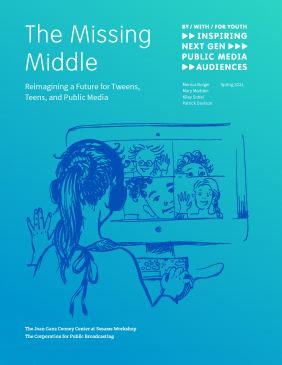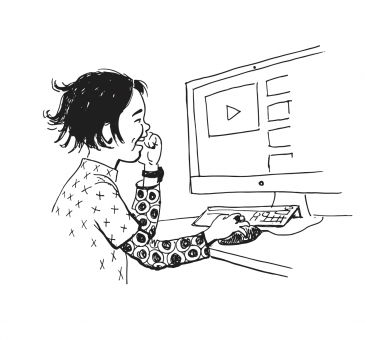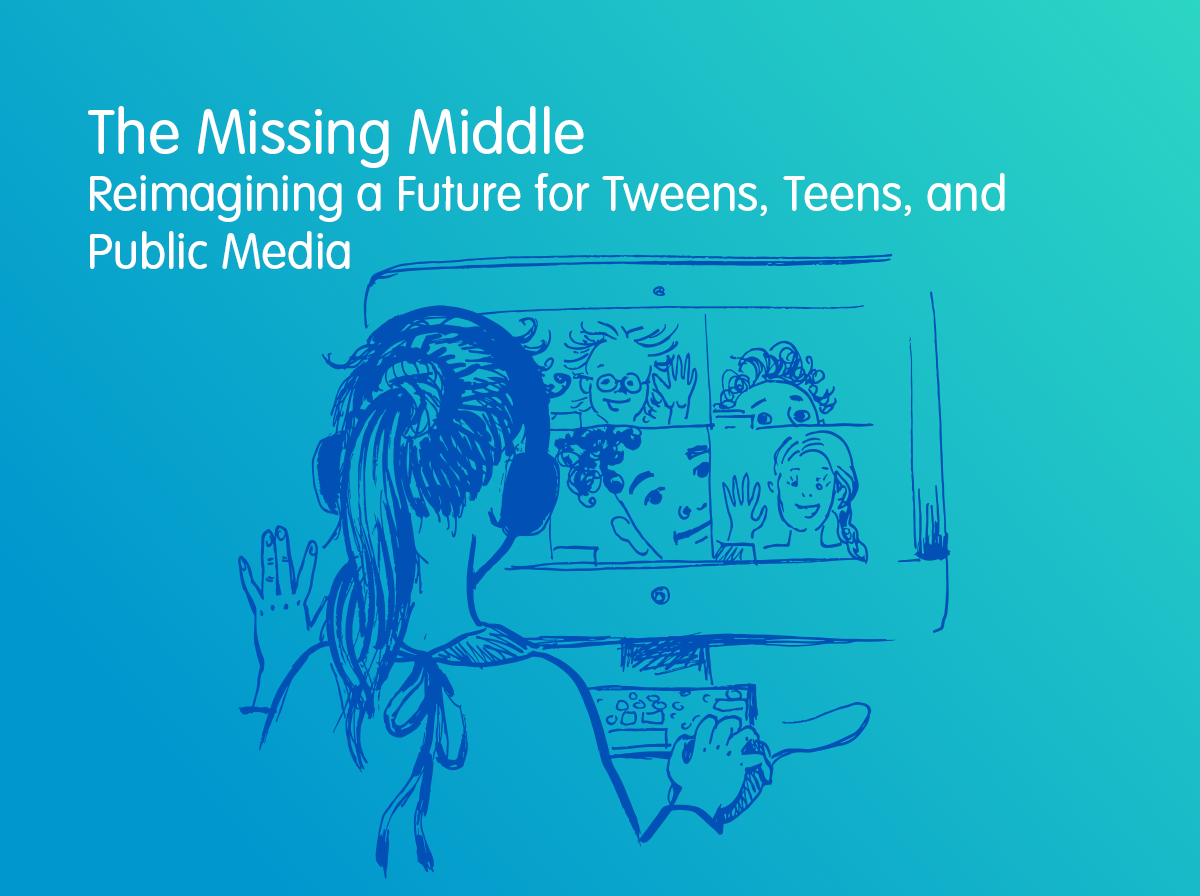
In the 1960s, Joan Ganz Cooney published The Potential Uses of Television in Preschool Education, a report that would revolutionize television for children. Where others saw a “vast wasteland,” Cooney saw possibility, and from it, educational programming for children, like Sesame Street and Mister Rogers’ Neighborhood, was born. Half a century later, the Joan Ganz Cooney Center and Corporation for Public Broadcasting seek to carry forward this vision of programming with the By/With/For Youth: Inspiring Next Gen Public Media Audiences project, which aims to foreground youth input into programming that serves them. The focus of this initiative is tweens and teens, identified as a “missing middle” audience for public media.
Today we are celebrating the launch of The Missing Middle: Reimagining a Future for Tweens, Teens, and Public Media. This report is the result of more than a year’s worth of research, interviews, and analysis. It is, to our knowledge, the first report of its kind to focus on asking American tweens and teens to reflect on their own media behaviors and preferences while also advising public media about what they would like to see in future programming and digital content. The purpose of the research is to help public media better serve and inspire today’s youth as they learn and grow in the context of a constantly expanding and fragmented media landscape. By amplifying the voices of 50 tweens and teens across the U.S. who discussed their media practices in focus groups last fall, our report also shines a light on how the role of technology in young people’s lives has changed during the pandemic.
When this initiative launched at the beginning of 2020, we could not have anticipated the dramatically different shape our research (and the world!) would take. Yet shifting from in-person focus groups, normally conducted at schools or after-school programs, to Zoom meetings conducted in kitchens, hallways, and bedrooms allowed an unprecedented snapshot of children’s lives amidst the ever-changing learning and living conditions of the pandemic.
The 10-17-year-olds we spoke with described spending their free time moving seamlessly across platforms and devices depending on their moods, their interests, and their access to certain kinds of connectivity. Many families loosened their screen time rules out of necessity, and teens and tweens largely used their free time online to socialize with friends. Video dominated their media experiences and was the lifeblood for social media and gaming. Youth increasingly sought out how-to videos to help answer questions, support interests they wished to explore, or simply solve a problem.
Yet while tweens and teens were grateful for digital media to help maintain connections with friends and family, many expressed eventually reaching a state of boredom with technology. As a 13-year-old in Brooklyn said:
“Now I’m on it [the computer] like six, seven, eight hours a day doing schoolwork, and then when I get off… I feel like I can’t go outside or I can’t do all these things, ‘cause it’s completely different, the world.”
And a 14-year-old in San Antonio echoed this sentiment:
“I haven’t really liked it, ever since quarantine started, because I was always super busy-busy-busy on the go, always doing something, always involved in something, and then it just all stopped, out of nowhere…So I definitely adjusted to it, but I like how it was before, and I know that it’s never gonna go back to how it was.”
Some youth we spoke with found the stress of hours spent in front of a screen managing a flood of new communications and deadlines overwhelming. Yet others, especially students with disabilities, expressed appreciation for learning from home and asynchronous assignments.
Some youth shared that the lost routines and support structures that school provides added to a sense of disconnectedness.
For others, remote learning both exacerbated existing economic and racial inequalities and made them more visible. We heard from tweens and teens who encountered challenges such as not having reliable access to high-speed connections or were trying to learn on a shared computer or mobile phone. Others reported living in households that lacked the advanced digital literacy skills necessary to access and use the many technologies necessary for learning from home.
Young people who have access to digital devices and connectivity enjoy an abundance of options for watching, playing, and listening, but are often underserved in terms of quality content appropriate to their developmental stages and needs. Many of the participants mentioned a desire for media that portray more authentic representations of youth, and expressed interest in contributing their input to the development of future programming.
Many also expressed a need for sources of trustworthy information that could help them discern fact from fiction, especially about social issues that they feel are important, and signaled a need to make their voices heard about causes that matter to them. One 15-year-old in the Bronx shared:
“Greta Thunberg, she’s only 16 and she’s already fighting for and protesting about all this stuff. I think that motivates and inspires me a lot because I love speaking up for things that are not right, and I also joined debate, which also inspired me to make my voice heard, and I think that is so important.”
When invited to share their advice for public media, youth often asked for media that addresses the everyday challenges that tweens and teens face, and stories that reflect the diversity they see in their generation. A 13-year-old in Arlington said:
“I think that our generation is a lot more about change, and I feel like sometimes some adults don’t really fully understand that.”
Public media is already a space known and trusted for a diversity of voices in its programming. In 2020, it provided resources across its networks for discussions of race, inequality, and prejudice. There is an opportunity here to amplify how public media goes beyond binaries and into the nuance of issues, since this seems to be missing, but much desired, in youth media experiences.
Our method of talking to tweens and teens, asking for their opinions, and thinking about what is possible is a model moving forward for public media to consider. Kids are grateful for a chance to be heard, and they were surprised that we were taking their opinions seriously. One space where public media can differentiate from commercial platforms is adults taking seriously what kids have to say.
Similar to the “vast wasteland” moment Joan Ganz Cooney faced in the 1960s, the abundance of content and personalization of the current moment can seem more noise than promise. Public media has an opportunity to evolve Cooney’s blueprint of a kinder learning space for young children into one that also addresses the pressing needs of tweens and teens. Our discussion with tweens and teens indicate that this is a moment to be visionary, to leverage the trusted space of public media for learning and growing as youth transition from childhood to adulthood, and develop identities deeply intertwined with their media ecosystems.
Download the full report here.




